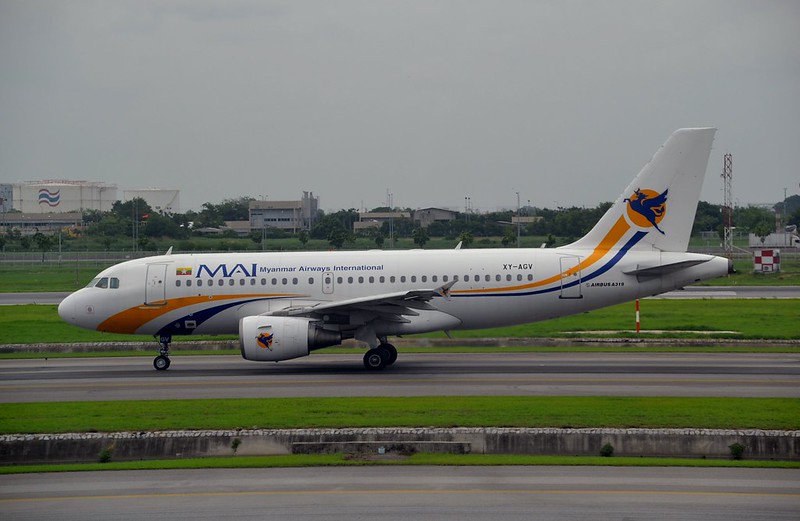
Each night for more than a week, unregistered flights between Yangon and Kunming have been transporting unknown goods and personnel from China to Myanmar. The military regime that’s now in charge of Myanmar is trying very hard to hide the flights. The Chinese government and Myanmar Airways have claimed the planes were carrying seafood exports. However, the details of the flights in question make that highly unlikely.
When the Myanmar military, the Tatmadaw, took over the country, it banned international flights. Very few flights are now using Yangon airport, and even fewer are flying internationally. But averaging five flights a night, up to three planes have been making trips to Kunming in southern China. Two of the planes are painted with Myanmar Airways colours and the other is unmarked. All of them are leased from private firms, so they should be in good working order.
Whoever has arranged these flights is going to great lengths to hide them. The planes’ transponders have been turned off, a violation of international aviation rules. We know the transponders work because we can see that they have been turned off for specific flights and then turned on for others. Beyond that, the Kunming Airport hasn’t registered them online as arrivals. Flight data is often missing from international flight databases, including flight numbers, call signs and even destinations. The failure to include scheduled departure and arrival times, as opposed to the actual times, makes it particularly difficult to track them on open-source flight databases.
But we do have the information sent via satellite from the engines (akin to what was used to investigate the fate of Malaysia Airlines flight MH370). And airport workers in Yangon and members of Myanmar’s civil disobedience movement opposed to the military coup have posted photos on Twitter from the airport of flight details and nightly arrivals and departures of the planes.
The three aircraft bear the registrations XY-AGV, XY-ALJ and XY-ALK. Most of the flights have been undertaken by XY-ALJ, which is an Airbus A320-214 painted plain white, and XY-AGV, an Airbus A319-111 bearing the livery of Myanmar Airways International. The A320-214 is owned by DAE Capital and the A319-111 is owned by AerCap Holdings.
The situation in Myanmar suggests two possibilities for what the planes are carrying. One is that they’re bringing in Chinese troops and cyber specialists to help the Tatmadaw control access to information and the internet. The other is that they’re increasing the Tatmadaw’s weapons stores.
Last year, the International Court of Justice ordered Myanmar to ‘take all measures within its power to prevent the commission’ of acts of genocide, particularly against its Rohingya minority population. However, if past behaviour is a predictor of future behaviour, the prospect of violent action against minority groups and other civilians in the country increased drastically when the military took over. This is especially the case for the Kachin on Myanmar’s northern border with China, and the 600,000 Rohingya remaining in Rakhine State, bordering Bangladesh.
It is common ahead of large-scale genocidal campaigns or campaigns to violently quell civil disobedience to see a sharp increase in weapons imports. Before the Rwandan genocide, for example, there was a notable increase in shipments of machetes. When South Africa was under international anti-apartheid sanctions, weapons were shipped from Burma to support the work of South African police.
It wouldn’t take particularly sophisticated weaponry for the Tatmadaw to continue its genocide of the Rohingya, but it would take volume and ammunition. Surveillance drones would help, as would simple rockets and area weapons. Although the ‘clearance operations’ of 2017 were a joint military affair, with fixed- and rotary-wing air support, the main effort was by the land forces, primarily with light vehicles, light weapons, knives and fire. The Kachin have had an organised resistance army for decades and have been subjected to more advanced weaponry. But the Tatmadaw have a long history of extreme brutality towards civilians, disregard for minority groups and egregious violence against women. These are all early warning signs for genocidal attacks, so we must be alert to any influx in weapons or ammunition.
China is the fifth largest arms exporter in the world, exporting well over 16.2 billion units of ammunition in the past 15 years. Beijing has been favouring deals with partners from the Belt and Road Initiative, and Myanmar has been one of the top three importers for the past decade. Kunming, in particular, is home to a significant artillery unit, the 63rd Base of the People’s Liberation Army Rocket Force, as well as a range of signals intelligence and cyber units, including one focused on operations in Southeast Asia. As a regional hub, the city also has significant storage and logistics facilities and an air base.
But Myanmar also buys much of its military hardware from Russia and the planes in question have also visited Cam Ranh Air Base, a former Russian outpost in Vietnam, to which Russians continue to have simplified access. In the weeks ahead of the coup, Senior General Min Aung Hlaing met with Russian Defence Minister Sergey Shoigu in Myanmar, finalising a supply agreement for surface-to-air-missiles, surveillance drones and radar equipment. At the end of the visit, the general thanked the minister for the visit, saying, ‘Just like a loyal friend, Russia has always supported Myanmar in difficult moments.’
The UN Security Council has long been prohibited from getting involved in Myanmar due to the influences of China and Russia. We still don’t know if either country knew what Min Aung Hlaing was planning in the weeks ahead of the coup. Although it took several days, it was encouraging to see the Security Council at least agree on a statement condemning the coup. Genocide, however, is a different issue. It is clearly a matter of international peace and security and should warrant a much clearer and firmer response from the international community.
The contents of those planes may well tell us what is ahead.

